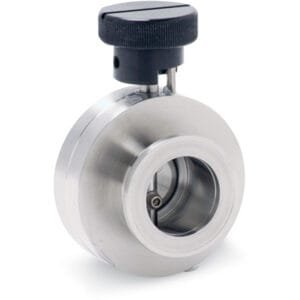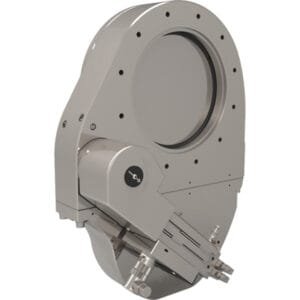Overview of ConFlat Flanges
The CF (ConFlat) flange is the most prevalent choice for high vacuum (HV) and ultra-high vacuum (UHV) applications, serving as the foundation for a variety of gauges, instruments, accessories, and feedthroughs.
Blank (Blind) Flanges
A blank or blind flange is essentially a solid, disc-shaped fitting designed for vacuum systems. It can be machined to create customized fittings or to seal off unused tubing sections and ports on vacuum chambers.
Seal Mechanism
The sealing mechanism of the CF flange involves a knife-edge that is machined beneath the flange’s flat surface. When the bolts of a flange pair are tightened, these knife-edges create annular grooves on either side of a soft metal gasket. This design allows the extruded metal to fill in any machining marks and surface defects, ensuring a leak-tight seal. The CF seal operates effectively at pressures ranging from 760 torr (103 mbar) down to less than 1 x 10^-13 Torr (approximately 1.3 x 10^-13 mbar) and within a temperature range of -196°C to 450°C, depending on the material used.
Flange sizes in North America are typically identified by their outside diameter (O.D.), while in Europe and much of Asia, the nominal internal diameter (I.D.) of the largest tube that can be welded to a bored flange is more commonly referenced.
Types of ConFlat Flanges
ConFlat flanges are available in four configurations:
- Fixed Flange: This one-piece design has a fixed bolt-hole orientation relative to the fitting.
- Rotatable Flange: Composed of two parts—a stationary inner weld ring and a rotating outer bolt ring—this design allows the bolt ring to turn around the inner weld ring.
Both fixed and rotatable flanges can be customized with either through (clearance) holes or tapped holes, providing versatility to suit various application needs.
Ordering Table
| Flange Size/OD | Type | Part Number |
| DN16CF (1.33" OD) | Fixed | F0133X000N |
| DN16CF (1.33" OD) | Fixed Weldneck | F0133X000NW |
| DN25CF (2.13" OD) | Fixed | F0212X000N |
| DN35CF-DN40CF (2.75" OD) | Fixed | F0275X000N |
| DN50CF (3.38" OD) | Fixed | F0337X000N |
| DN63CF (4.50" OD) | Fixed | F0450X000N |
| DN75CF (4.63" OD) | Fixed | F0462X000N |
| DN100CF (6.00" OD) | Fixed | F0600X000N |
| DN125CF (6.75" OD) | Fixed | F0675X000N |
| DN160CF (8.00" OD) | Fixed | F0800X000N |
| DN200CF (10.00" OD) | Fixed | F1000X000N |
| DN250CF (12.00" OD) | Fixed | F1200X000N |
| DN275CF (13.25" OD) | Fixed | F1325X000N |
| DN295CF (14.00" OD) | Fixed | F1400X000N |
| DN350CF (16.50" OD) | Fixed | F1650X000N |




Reviews
There are no reviews yet.